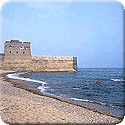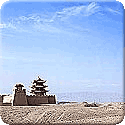Region: 安徽Anhui
-

The entrance to the village. Twelve memorial arches once grace the flat area by the lake. All but one were destroyed during the cultural revolution in the 1960s.
-

View of the grand arch from within the village.
-
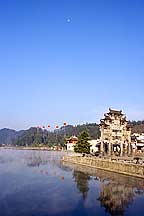
The grand arch beside the lake at sunset
-

The Ming official 胡文光 Hu Wengang, a native of Xidi, had the stone arch created in 1578. It stands 12.3 meters high and 9.95 meters wide, the largest of its kind in Huangshan city today. It used the ratio of 三门四柱五楼 Three Doors,Four Pillars and Five Roofs.
-

A girl combing her hair in the shade of the grand arch. The intricately sculpted stone arch has carved images of dragons,unicorns,Daoist animals and deities
-

Rooftops at dawn. The unusal white walls with cascading small roofs are called "马头墙 Horsehead Wall"--so named because the white wall and tiled roof resemble a white horse and its mane flying in the air. It is a distinctive Anhui architectural trait.
-

Black and White film version of the previous scene.
-

Vertcial view of the same rooftops.
-

yet another view of the same rooftops, only wider.
-

More rooftops at a different area. Although the horsehead walls are unusual, most of the houses have gable roofs.
-

The uniform white-painted walls of the houses sets the village apart from the surrounding mountains and trees.
-

The houses are not aligned along a grid plan like those of the the capitals, but along curves. When the sun is out, the light bounces around the white walls and glows in unusual areas.
-

The cluster of houses in the village looks like clusters of stars in a galaxy. It has a natural order that looks delightful, and a randomness that keeps the viewer curious. I am looking at all these from the flat rooftop of the inn that I stayed for the night. Unfortunately, the building isn't part of the pack. It is a three-story rack! But I got these pictures from above it, reason enough to stay here.
-

I was up on the roof before sunrise,and although it was late September, the air was cold and the wind was blowing persistently. With only a t-shirt, I ran back and forth from my Hasselblad to the surrounding low wall where I crouch to warm up for the next shot.
-
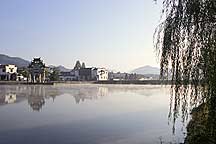
The lake is small. I walked on a small foot path that leads to entrance of the village.
-

This view was from the main road side of the village. I saw a small red pavillion perched on the side of a hill which persuaded me out of the village to its platform. I took this photo on the way. The shrubby path up was narrow with some parts fenced on both sides of the way. I passed several houses and sheds to get to the lonely pavillion. Once under its roof, I was disappointed with what I can see. There were too many trees and fences breaking up the view. I went back down to the village and tries to get back to the village the same way I went out: however, there were three old men sitting atop the low wall, which surroundes the roadside part of the village, forbading me from getting back in. The rule here is per ticket per single entry. They didn't want a single ticket to be used by several people. So I have to reason with them. I explained that I came out to get to the pavillion to have a bird's eye view of the grand village. And since the pavillion is part of the village, I am technically still inside. They nodded, and I quickly went back in. I have to persuade another group one more time later when I missed the bus back to town. I said I missed the last bus back to town, so now I like to stay overnight inside the village. They shook their heads. They didn't believe I am the owner of the ticket. They want proof that was inside. Well, giving them names of well-known houses did not work. But I was in luck, because previously I went in an inn where I asked if there was a rooftop I can used to take photos. Unfortunately, I forgot the name of the inn. I describe the rooftop to them. Getting to the rooftop waas unusual(I think)because I have to climb a narrow, vertical metal ladder. They question one another for a minute, and then someone nodded. I went straight to the inn and book a bed.
-

This view if from the opposite side of the previous one. I hiked on the wide path up the mountain. But I could not find a clean view of the entire village.
-

A view of about 3/4 of the village houses. I am looking from the mountain road, where the road edge were lined with trees.
-
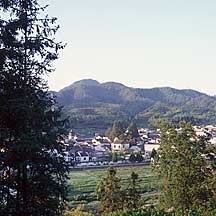
Another view from the mountain.





